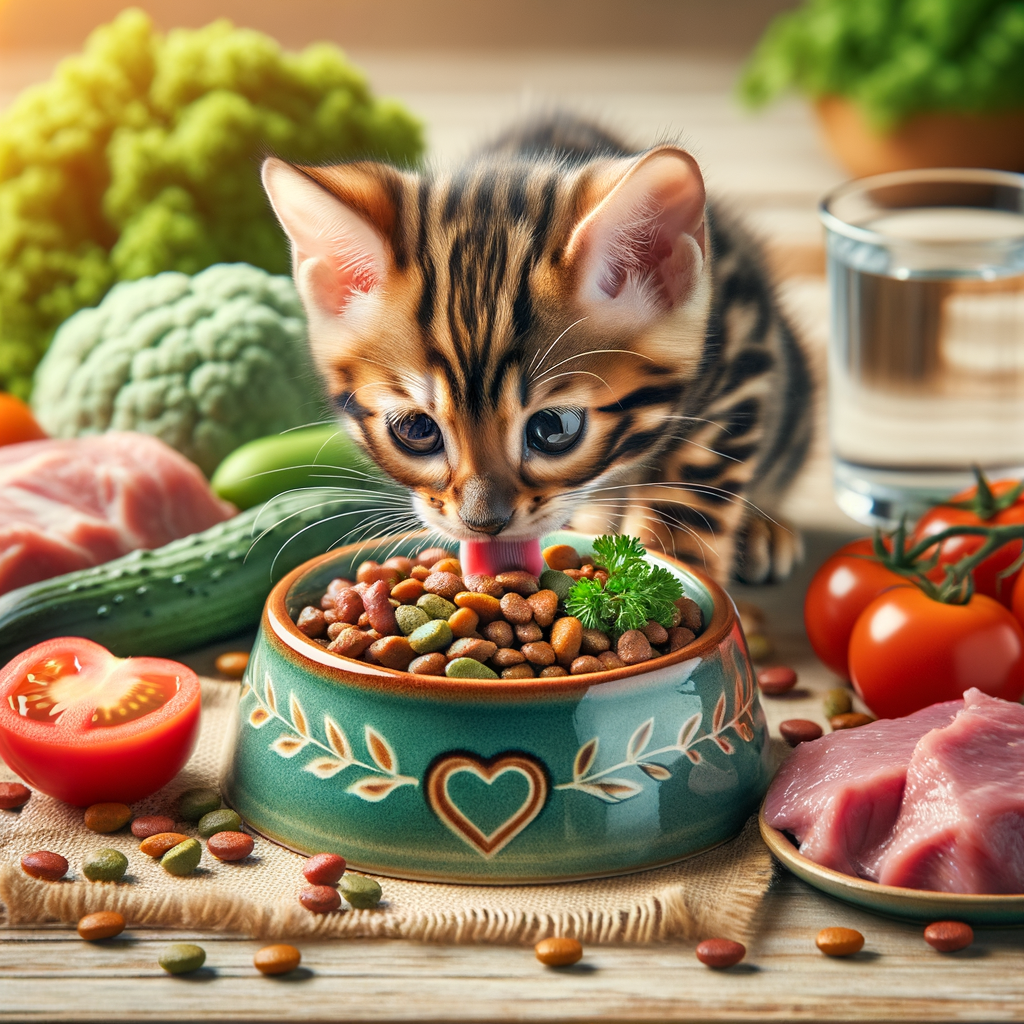
Introduction to Nutritional Needs of Bengal Kittens
- Importance of a balanced diet for Bengal kittens:
A balanced diet helps Bengal kittens grow properly. It gives them the energy to play and explore. Without the right nutrients, they can get sick or not grow as they should.
- The unique dietary requirements of Bengal kittens:
Bengal kittens have special dietary needs. They need more protein than other cats. They also need certain vitamins and minerals to keep their fur shiny and their muscles strong.
Bengal Kitten Diet: An Overview
Best Food for Bengal Kittens
-
- Commercial kitten food vs homemade food
Choosing between commercial kitten food and homemade food can be tough. Commercial foods are convenient and balanced. They contain all the nutrients your kitten needs. Homemade food can be great too, but it requires careful planning to ensure it meets all nutritional needs.
-
- Recommended brands for Bengal kitten food
Some brands are known for their high-quality kitten food. Here are a few recommended ones:
| Brand | Key Features |
|---|---|
| Hill’s Science Diet | Balanced nutrition, easy to digest |
| Royal Canin | Supports immune system, promotes healthy growth |
| Blue Buffalo | Natural ingredients, no artificial preservatives |
Bengal Kitten Feeding Guide
-
Feeding Frequency and Portion Sizes
Age (weeks) Feeding Frequency Portion Size 0-4 Every 2-3 hours Small amounts of mother’s milk or formula 4-8 4-5 times a day 1-2 tablespoons of wet food 8-12 3-4 times a day 1/4 to 1/3 cup of kitten food 12+ 2-3 times a day 1/3 to 1/2 cup of kitten food As your kitten grows, you can gradually reduce the feeding frequency and increase the portion size. Always ensure fresh water is available.
-
Transitioning from Mother’s Milk to Solid Food
Start the weaning process when the kitten is about 4 weeks old. Begin by offering a mixture of kitten formula and wet food. Gradually increase the amount of wet food while decreasing the formula.
By 8 weeks, your kitten should be eating mostly solid food. Make sure to choose high-quality kitten food that meets their nutritional needs.
Here are some tips for a smooth transition:
- Introduce new foods slowly to avoid digestive issues.
- Offer small, frequent meals to help them adjust.
- Monitor their weight and growth to ensure they are eating enough.
Nutrients for Bengal Kittens
Bengal Kitten Protein Requirements
- The role of protein in a Bengal kitten’s diet: It helps them grow strong muscles and supports their overall health. Without enough protein, kittens can become weak and sick.
- Sources of high-quality protein for Bengal kittens: Bengal kittens need high-quality protein sources. Good options include chicken, turkey, and fish.
| Protein Source | Benefits |
|---|---|
| Chicken | Rich in essential amino acids and easy to digest |
| Turkey | High in protein and low in fat |
| Fish | Contains omega-3 fatty acids for a healthy coat |
Bengal Kitten Vitamin Needs
-
Vitamins for Bengal kittens
-
- Vitamin A: Helps with vision and immune function.
- Vitamin D: For bone growth and strength.
- Vitamin E: Protects cells and supports skin health.
- Vitamin K: Helps with blood clotting.
- B Vitamins: Aid in energy production and brain function.
- Vitamin C: Supports the immune system.
-
-
How to ensure your Bengal kitten is getting enough vitamins
-
-
- Balanced Diet: Feed your kitten a balanced diet with high-quality kitten food.
- Check Labels: Look for kitten food that lists vitamins.
- Consult Your Vet: Always talk to your vet about your kitten’s diet and vitamin needs.
- Supplements: If needed, your vet may recommend vitamin supplements.
-
| Vitamin | Benefit |
|---|---|
| Vitamin A | Vision and immune function |
| Vitamin D | Bone growth and strength |
| Vitamin E | Cell protection and skin health |
| Vitamin K | Blood clotting |
| B Vitamins | Energy production and brain function |
| Vitamin C | Immune support |
Bengal Kitten Meal Plan
Sample Meal Plan for a Bengal Kitten
| Time | Meal | Portion Size |
|---|---|---|
| 7:00 AM | Wet food | 1/4 cup |
| 12:00 PM | Dry food | 1/8 cup |
| 5:00 PM | Wet food | 1/4 cup |
| 9:00 PM | Dry food | 1/8 cup |
This plan ensures your Bengal kitten gets a mix of wet and dry food. Wet food helps with hydration, while dry food is good for their teeth.
Adjusting the Meal Plan as Your Bengal Kitten Grows
- Increase Portion Sizes: As your kitten gets bigger, they will need more food. Gradually increase the portion sizes.
- Change Feeding Times: Older kittens may need fewer meals per day. You can reduce the number of meals but increase the portion size.
- Monitor Weight: Keep an eye on your kitten’s weight. If they are gaining too much or too little, adjust their food intake accordingly.
- Consult Your Vet: Always check with your vet before making significant changes to your kitten’s diet.
Bengal Kitten Growth Nutrition
Monitoring Your Bengal Kitten’s Growth
- Bengal kitten growth stages: Bengal kittens go through several growth stages. From birth to 2 weeks, they are newborns. At 3-8 weeks, they are in the weaning stage. From 9 weeks to 4 months, they are in the early growth stage. Finally, from 4 months to 1 year, they are in the adolescent stage.
- Signs of healthy growth in Bengal kittens: Healthy Bengal kittens should gain weight steadily. They should be active, playful, and have a shiny coat. Their eyes should be bright, and they should have a good appetite. Regular vet check-ups can help monitor their growth and catch any issues early.
| Growth Stage | Age Range | Key Characteristics |
|---|---|---|
| Newborn | 0-2 weeks | Dependent on mother, eyes closed |
| Weaning | 3-8 weeks | Starting to eat solid food, exploring |
| Early Growth | 9 weeks-4 months | Rapid growth, very playful |
| Adolescent | 4 months-1 year | Slower growth, more independent |
Healthy Diet for Bengal Kittens
Hydration Tips for Bengal Kittens
- The importance of hydration for Bengal kittens
Water helps their bodies work well. It keeps their skin and fur healthy. It also helps their digestion and keeps their kidneys working right.
- Tips to encourage your Bengal kitten to drink more water
-
- Fresh Water: Always provide fresh water. Change it at least once a day.
- Multiple Bowls: Place water bowls in different areas of your home. This makes it easy for your kitten to find water.
- Wet Food: Include wet food in their diet. Wet food has more water than dry food.
- Water Fountain: Use a pet water fountain. Many kittens like to drink moving water.
- Ice Cubes: Add ice cubes to their water bowl. Some kittens enjoy playing with and licking ice cubes.
Ensuring a Balanced Diet for Your Bengal Kitten
- Review of key points:
- Bengal kittens need a diet rich in protein and fat.
- Nutrients include vitamins, minerals, and amino acids.
- A balanced meal plan should include wet and dry food.
- Monitor your kitten’s growth and adjust the diet as needed.
- Final tips for maintaining a healthy diet for your Bengal kitten:
- Always provide fresh water.
- Feed your kitten multiple small meals a day.
- Avoid feeding human food or table scraps.
- Consult your vet for personalized diet advice.
- Regularly check the food labels for quality ingredients.
| Key Nutrient | Importance |
|---|---|
| Protein | Supports muscle growth and energy |
| Fat | Provides energy and supports brain development |
| Vitamins | Essential for overall health and immune function |
| Minerals | Supports bone health and metabolic processes |
| Amino Acids | Building blocks of protein, crucial for growth |






